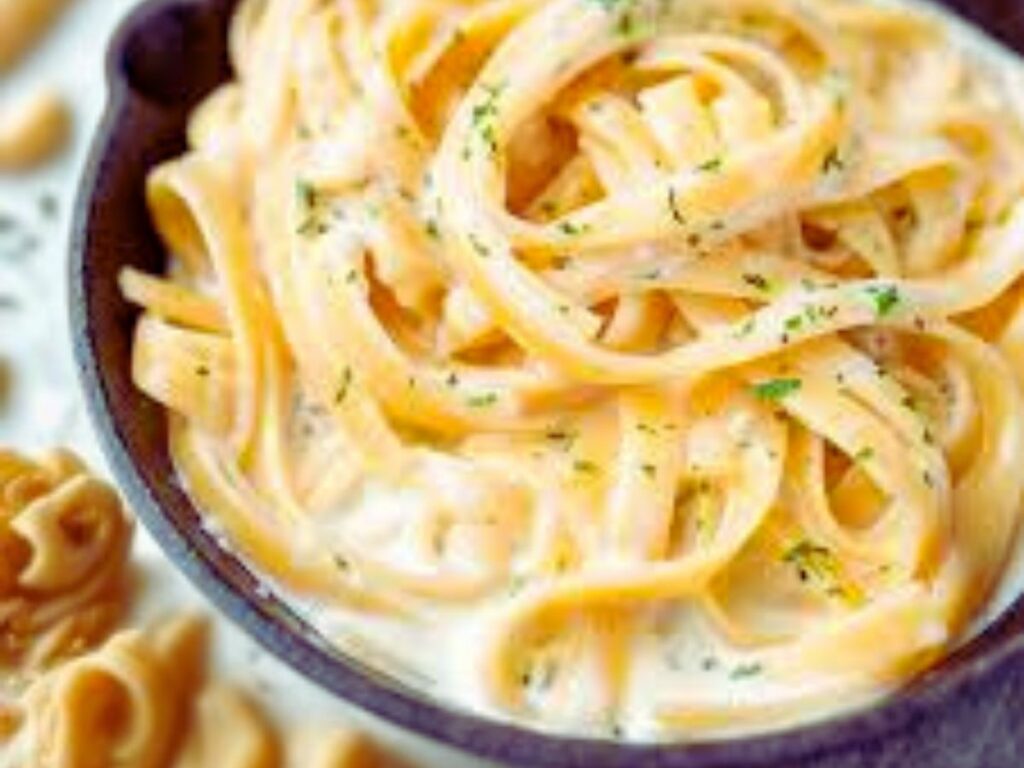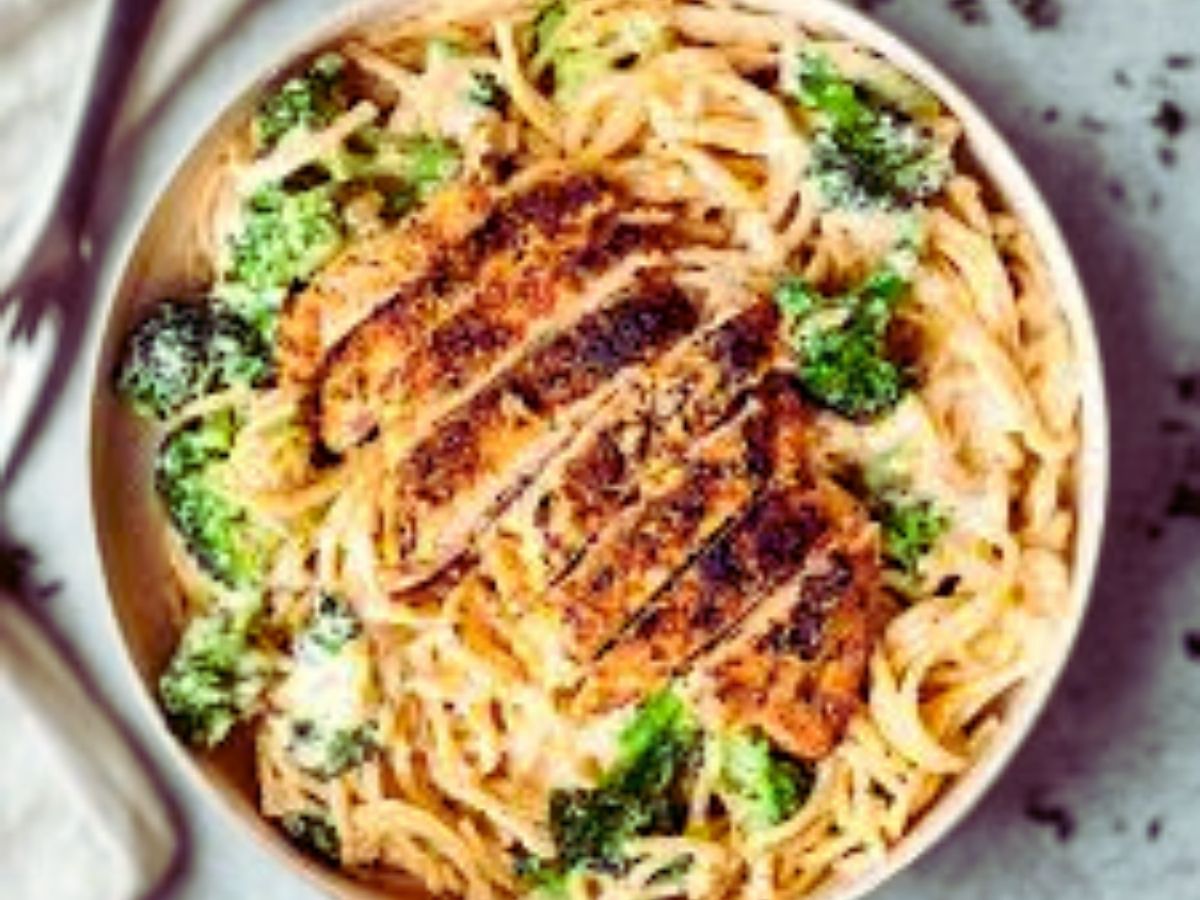Imagine twirling your fork through silky, creamy pasta that rivals your favorite Italian restaurant—and having it ready in just 20 minutes! That’s exactly what this easy fettuccine alfredo recipe delivers. No complicated techniques, no hard-to-find ingredients, just pure comfort food perfection.
Fettuccine alfredo is the ultimate comfort meal: tender pasta ribbons coated in a luxuriously rich, buttery cream sauce. Whether you’re cooking for a special date night, feeding hungry family members, or simply craving something indulgent, this homemade alfredo sauce recipe is your answer.
What makes this easy fettuccine alfredo recipe truly special is its simplicity. You don’t need culinary school training or fancy equipment. With just a few basic ingredients and one pot, you’ll create a dish that tastes like it took hours. Plus, I’ll share the secret to making perfectly smooth, never-grainy alfredo sauce that stays creamy every single time.
Ready to master the art of easy fettuccine alfredo recipe? Let’s get cooking!
Recipe Overview
| Prep Time | 5 minutes |
| Cook Time | 15 minutes |
| Total Time | 20minutes |
| Yield | 4 portions |
| Difficulty Level | Easy |
| Cuisine | Italian-American |
This easy fettuccine alfredo recipe easy version delivers authentic Italian-American flavor without the fuss. The creamy alfredo sauce comes together while your pasta cooks, making this a true one-pot wonder. It’s rich, indulgent, and surprisingly simple—perfect for busy weeknights or when you want to impress guests without spending hours in the kitchen.
Are Fettuccine And Alfredo The Same Thing?
This is a common question! Let me clear up the confusion:
Fettuccine is a type of pasta—flat, thick ribbons similar to linguine but wider. The name comes from the Italian word “fettuccia,” meaning “little ribbon.”
Alfredo refers to the creamy sauce made with butter, cream, and Parmesan cheese. It’s named after Alfredo di Lelio, who created it in Rome in the early 1900s.
Fettuccine Alfredo is the complete dish—fettuccine pasta tossed in Alfredo sauce. So they’re not the same thing; rather, they’re two components that come together to create one iconic dish!
You can use alfredo sauce with other pasta shapes (like penne or linguine), and you can use fettuccine with different sauces (like marinara or pesto). But when combined, they create the classic comfort food we all love!
Ingredients
For The Fettuccine:
- 12 oz (340g) fettuccine pasta (dried or fresh)
- 4-6 quarts of water for boiling
- 1 tablespoon salt (for pasta water)
For The Homemade Alfredo Sauce:
- 4 tablespoons unsalted butter (½ stick)
- 1 cup heavy cream (or heavy whipping cream)
- 1½ cups freshly grated Parmesan cheese (about 4 oz)
- 2 cloves of garlic, minced (optional but recommended)
- ¼ teaspoon salt (or to taste)
- ¼ teaspoon black pepper (freshly ground)
- Pinch of nutmeg (optional, adds depth)
Optional Add-Ins:
- Fresh parsley for garnish
- Red pepper flakes for a little heat
- Extra Parmesan for serving
- 1-2 teaspoons lemon juice (brightens the flavor)
Important Note: Always use freshly grated Parmesan cheese! Pre-grated cheese contains anti-caking agents that prevent it from melting smoothly, resulting in a grainy sauce.
What Are The Basic Ingredients For Alfredo?
Traditional alfredo sauce uses just three core ingredients:
- Butter – Provides richness and helps create the silky texture
- Parmesan Cheese – The star flavor component; authentic Parmigiano-Reggiano is best
- Pasta Water – The starchy cooking liquid helps bind everything together
The 3-ingredient alfredo sauce (authentic Italian version) uses only these three components! However, the American version—which most people prefer—adds heavy cream for extra richness and creaminess. This recipe uses the American-style approach because it’s more stable and consistently creamy.
Optional flavor enhancers include:
- Garlic – Adds aromatic depth
- Black pepper – Provides subtle heat
- Nutmeg – A Traditional Italian addition that adds warmth
- Salt – Enhances all the flavors
That’s it! No flour, no cream cheese, no complicated ingredients. Just simple, quality components that shine together.
Method/Procedure: How To Make Easy Fettuccine Alfredo
Step 1: Cook The Pasta
Fill a large pot with 4-6 quarts of water and add 1 tablespoon of salt. Bring to a rolling boil over high heat. Add the fettuccine and cook according to package directions until al dente (usually 8-12 minutes for dried pasta, 2-3 minutes for fresh).
Important: Reserve 1 cup of pasta cooking water before draining! This starchy liquid is a secret ingredient for perfect sauce consistency.
Drain the pasta (don’t rinse it!) and set aside.
Step 2: Start The Alfredo Sauce
While the pasta cooks, prepare your sauce. In a large skillet or sauté pan over medium heat, melt the butter completely. If using garlic, add it now and sauté for 30-60 seconds until fragrant but not brown. Burnt garlic tastes bitter!
Step 3: Add The Cream
Pour the heavy cream into the melted butter. Stir gently and let it come to a gentle simmer. Don’t let it boil vigorously—we want a gentle bubble around the edges. Simmer for 2-3 minutes, stirring occasionally, until the cream thickens slightly.
Step 4: Add The Cheese
Reduce the heat to low. Gradually add the freshly grated Parmesan cheese, about ¼ cup at a time, whisking constantly. Wait until each addition is fully melted before adding more. This prevents clumping and ensures a smooth, creamy sauce.
Pro Tip: If the sauce seems too thick, add 2-3 tablespoons of reserved pasta water and stir. The starch helps bind the sauce to the pasta.
Step 5: Season To Perfection
Once all the cheese is melted and the sauce is smooth, season with salt, black pepper, and a tiny pinch of nutmeg (if using). Taste and adjust seasoning as needed. Remember, Parmesan is already salty, so add salt carefully!
Step 6: Combine Pasta And Sauce
Add the drained fettuccine directly to the sauce in the pan. Using tongs, toss the pasta in the sauce for 1-2 minutes over low heat. This allows the pasta to absorb the flavors and helps the sauce cling to every strand. If the sauce is too thick, add more pasta water 1 tablespoon at a time until you reach your desired consistency.
Step 7: Serve Immediately
Transfer to serving plates or a large bowl. Garnish with extra Parmesan cheese, fresh black pepper, and chopped parsley. Serve immediately while hot and creamy!

What Is The Secret To A Good Alfredo Sauce?
The secrets to perfect, restaurant-quality alfredo sauce are:
1. Use Freshly Grated Parmesan
Pre-shredded cheese contains cellulose (an anti-caking agent) that prevents smooth melting. Always grate your own from a block of authentic Parmigiano-Reggiano or high-quality Parmesan.
2. Low And Slow With The Cheese
Add cheese gradually over low heat, whisking constantly. High heat causes the proteins to seize and separate, creating a grainy, broken sauce.
3. Reserve Pasta Water
The starchy pasta water is liquid gold! It helps emulsify the sauce, making it silky and helping it cling to the pasta. Always save at least 1 cup before draining.
4. Don’t Boil The Cream
Gentle simmering is key. Boiling can cause the cream to separate or the sauce to become grainy. Keep the heat medium-low once you add the cheese.
5. Proper Pasta-To-Sauce Ratio
Don’t drown your pasta in sauce! The goal is to coat each strand evenly, not swim in a pool of cream. About ¾ to 1 cup of sauce per 3 oz of dried pasta is perfect.
6. Serve Immediately
Alfredo sauce thickens as it cools and can break if reheated improperly. Always make it fresh and serve it right away for the best texture.
7. Quality Ingredients Matter
Since there are so few ingredients, quality makes a huge difference. Use real butter, heavy cream (not half-and-half), and authentic Parmesan cheese.
What Is The Key To Fettuccine Alfredo?
The key to perfect fettuccine alfredo lies in three critical elements:
1. Texture: The sauce should be silky, creamy, and coat the pasta evenly—never watery or broken.
2. Temperature Control: Cook the sauce over low to medium-low heat. High heat causes separation and graininess.
3. Timing: Fettuccine alfredo is best served immediately. The magic happens when hot pasta meets fresh sauce, allowing them to marry together.
Additionally, tossing the pasta IN the sauce (not just pouring sauce over pasta) is essential. This technique, called “mantecatura” in Italian cooking, allows the pasta to absorb the sauce and creates better flavor and texture.
Serving Suggestions
This creamy fettuccine alfredo is delicious on its own, but here are ways to elevate it:
Protein Add-Ins:
- Grilled chicken (sliced or cubed) – makes chicken alfredo recipe
- Sautéed shrimp (seasoned with garlic and paprika)
- Pan-seared salmon (flaked and folded in)
- Crispy bacon or pancetta (chopped)
- Italian sausage (cooked and sliced)
Vegetable Additions:
- Steamed broccoli florets (classic pairing)
- Sautéed mushrooms (baby bella or cremini)
- Sun-dried tomatoes (adds tangy brightness)
- Fresh spinach (wilted into the sauce)
- Roasted cherry tomatoes (bursts of acidity)
- Grilled asparagus (elegant and seasonal)
Side Dishes:
- Garlic bread or breadsticks for soaking up sauce
- Caesar salad with crispy romaine
- Caprese salad with fresh mozzarella and tomatoes
- Roasted vegetables (zucchini, bell peppers, carrots)
- Antipasto platter with cured meats and olives
Presentation Tips:
- Twirl pasta into nests on individual plates
- Garnish with fresh parsley and cracked black pepper
- Add a lemon wedge on the side for brightness
- Serve with extra Parmesan at the table
- Use warm serving bowls to keep pasta hot longer
Storage And Temperature Guide
Immediate Serving (Best Option):
Fettuccine Alfredo is always best served fresh and hot. The sauce is at its creamiest and most delicious right after making it.
Room Temperature:
Do not leave fettuccine alfredo at room temperature for more than 2 hours. Dairy-based sauces can harbor bacteria growth when left out.
Refrigerator Storage:
Store leftovers in an airtight container in the refrigerator for up to 3-4 days. The sauce will thicken considerably as it cools—this is normal.
How to store properly:
- Let the pasta cool to room temperature (but within 2 hours of cooking)
- Transfer to an airtight container
- Press plastic wrap directly on the surface to prevent skin from forming
- Refrigerate promptly
Reheating Instructions:
Reheating Alfredo properly is crucial to avoid a broken, grainy sauce:
Stovetop Method (Best):
- Place pasta in a skillet over low heat
- Add 2-4 tablespoons of milk, cream, or pasta water
- Stir gently and continuously until heated through
- Add a splash more liquid if needed to restore creaminess
Microwave Method:
- Place pasta in a microwave-safe dish
- Add 2 tablespoons of milk or cream
- Cover with a damp paper towel
- Heat in 30-second intervals, stirring between each
- Add more liquid if the sauce looks broken or dry
Pro Tip: Add a tablespoon of butter when reheating to help re-emulsify the sauce!
Freezer Storage:
Alfredo sauce doesn’t freeze particularly well because cream-based sauces tend to separate when thawed. However, if you must freeze:
- Freeze for up to 1 month maximum
- Thaw overnight in the refrigerator
- Reheat gently with added cream, whisking vigorously
- Expect some texture changes
Better option: Freeze the cooked pasta and sauce separately, then combine when reheating.
Alternative Methods And Variations
Homemade Alfredo Sauce With Milk:
For a lighter version, replace heavy cream with whole milk:
- Use 1 cup whole milk + 2 tablespoons cream cheese (for thickness)
- Add 1 tablespoon of flour mixed with 2 tablespoons of milk (slurry for thickening)
- Follow the same method, but whisk continuously
- The sauce will be thinner but still creamy and delicious
3-Ingredient Alfredo Sauce (Authentic Italian):
For the traditional Roman version:
- 12 oz fettuccine + ½ cup butter + 2 cups freshly grated Parmesan
- Cook pasta and reserve 1 cup of pasta water
- Toss hot pasta with butter in a warm bowl
- Add Parmesan gradually while tossing
- Add pasta water to create a silky emulsion
- No cream needed!
Lightened Alfredo Sauce:
- Use half-and-half instead of heavy cream
- Reduce butter to 2 tablespoons
- Add ½ cup chicken or vegetable broth for volume
- Use reduced-fat cream cheese for the body
Garlic-Herb Alfredo:
- Add 4-5 minced garlic cloves
- Stir in 2 tablespoons fresh basil or parsley
- Add ½ teaspoon Italian seasoning
- Finish with fresh lemon zest
Cajun Alfredo:
- Season with 1-2 teaspoons Cajun seasoning
- Add ¼ teaspoon cayenne pepper
- Stir in sautéed bell peppers and onions
- Perfect with blackened chicken or shrimp
Chicken Alfredo Recipe:
- Season 1 lb chicken breast with salt, pepper, and Italian herbs
- Pan-sear or grill until cooked through (165°F internal temp)
- Slice or cube the chicken
- Add to the pasta and sauce, or serve on top
- Garnish with extra Parmesan and parsley
Seafood Alfredo:
- Sauté 1 lb shrimp or scallops in butter and garlic
- Add to the prepared alfredo
- Alternative: Use crab meat or lobster for the luxury version
- Finish with fresh lemon juice and parsley
Vegetarian Alfredo Variations:
- Broccoli alfredo (add 2 cups steamed florets)
- Mushroom alfredo (sauté 8 oz mixed mushrooms)
- Primavera Alfredo (add seasonal roasted vegetables)
Different Pasta Shapes:
While fettuccine is traditional, Alfredo sauce works beautifully with:
- Linguine (thinner ribbons)
- Penne (tube pasta holds sauce well)
- Rigatoni (large tubes for a hearty version)
- Tortellini or ravioli (stuffed pasta luxury)
- Spaghetti (if that’s what you have)
Nutritional Value
Per Serving (based on 4 servings, basic recipe):
| Calories | 685 kcal |
| Total Carbohydrates | 55g |
| Sugars | 2g |
| Protein | 22g |
| Fat | 42g |
| Fiber | 2g |
| Sodium | 520mg |
Note: Fettuccine alfredo is an indulgent dish meant for occasional enjoyment. It’s high in calories and saturated fat, but also provides good amounts of protein and calcium.
For Lighter Version (with half-and-half and reduced butter):
- Calories: 485
- Total Fat: 22g
- Saturated Fat: 13g
- Still rich but 200 fewer calories per serving
Nutritional Benefits:
- High in Calcium: From Parmesan and cream
- Good Protein Source: Especially with added chicken or shrimp
- Provides Energy: Carbohydrates for sustained energy
- Contains Vitamin A: From dairy components
Making It Healthier:
- Use whole wheat fettuccine for added fiber
- Increase vegetable content (broccoli, spinach)
- Reduce portion size and pair with a large salad
- Use the milk-based version instead of heavy cream
- Add lean protein like grilled chicken breast
Tips And Tricks For Perfect Fettuccine Alfredo
1. Always Grate Your Own Parmesan
This cannot be stressed enough! Pre-shredded cheese won’t melt smoothly. Buy a block of Parmigiano-Reggiano and grate it yourself using a box grater or food processor.
2. Use Room Temperature Cheese
If your cheese is straight from the fridge, let it sit out for 10-15 minutes. Room temperature cheese melts more easily and smoothly.
3. Save That Pasta Water!
Before draining, always scoop out at least 1 cup of the starchy cooking water. It’s your secret weapon for adjusting sauce consistency and helping it cling to pasta.
4. Don’t Rinse The Pasta
Never rinse cooked pasta! The starch on the surface helps the sauce adhere. Go straight from boiling water to sauce.
5. Cook Pasta Al Dente
Slightly undercooked pasta (al dente, meaning “to the tooth”) has a better texture and will finish cooking when tossed with the hot sauce.
6. Use A Wide Pan
A large skillet or sauté pan gives you room to toss the pasta with the sauce effectively. A narrow pot makes tossing difficult.
7. Keep Heat Low When Adding Cheese
High heat causes the cheese proteins to seize up and separate from the fats, creating a broken, grainy sauce. Always use low heat.
8. Add Cheese Gradually
Patience pays off! Adding cheese slowly while whisking constantly ensures smooth melting and even distribution.
9. Toss, Don’t Pour
Always toss the pasta IN the sauce rather than pouring sauce over pasta on a plate. This technique coats every strand evenly.
10. Serve In Warm Bowls
Warm your serving bowls or plates in a 200°F oven for a few minutes. This keeps the pasta hot longer and prevents the sauce from congealing.
11. Use Fresh Cream
Check the expiration date on your cream. Fresh cream emulsifies better and tastes cleaner than cream that’s about to expire.
12. Don’t Be Shy With Seasoning
Taste your sauce before adding the pasta! Parmesan is salty, but you may need a pinch more salt, pepper, or even a squeeze of lemon juice for balance.
Common Mistakes To Avoid
1. Using Pre-Shredded Cheese
The #1 mistake! Anti-caking agents prevent smooth melting. Always grate fresh Parmesan from a block.
2. Cooking Over High Heat
High heat causes the sauce to separate and become grainy. Always use medium-low to low heat, especially when adding cheese.
3. Adding All The Cheese At Once
This leads to clumping. Add gradually, ¼ cup at a time, whisking constantly.
4. Not Salting Pasta Water
Under-seasoned pasta makes the whole dish bland. Use about 1 tablespoon of salt per 4 quarts of water—it should taste like the sea!
5. Rinsing The Pasta
This washes away the starch that helps sauce cling. Never rinse pasta for this dish.
6. Making The Sauce Too Far In Advance
Alfredo sauce is meant to be served immediately. It thickens and can break as it sits.
7. Pouring Sauce Over Pasta Instead Of Tossing
This results in unevenly coated pasta. Always toss the pasta IN the sauce in the pan.
8. Using Low-Quality Ingredients
With so few ingredients, quality matters! Use real butter, heavy cream, and authentic Parmesan.
Frequently Asked Questions (FAQs)
Can I make Alfredo sauce ahead of time?
It’s best to make Alfredo sauce fresh, but you can prep ingredients ahead. Grate the cheese, measure the cream, and have everything ready. Make the sauce just before serving for the best results.
Why did my Alfredo sauce separate or break?
Separation happens from too much heat or adding cheese too quickly. Always use low heat and add cheese gradually while whisking. If it breaks, whisk in 1-2 tablespoons of pasta water to help re-emulsify.
Can I use half-and-half instead of heavy cream?
Yes, but the sauce will be thinner. For best results, add 1-2 tablespoons of cream cheese or 1 tablespoon of flour (mixed with milk first) to add body and prevent separation.
What if I don’t have fettuccine?
Any pasta works! Try linguine, penne, rigatoni, or even spaghetti. The sauce is what makes it “alfredo,” not specifically the pasta shape.
How do I make homemade alfredo sauce with milk?
Replace heavy cream with 1 cup whole milk plus 2 tablespoons cream cheese. Mix the cream cheese with a little warm milk first to smooth it out, then add it to the butter and proceed with the recipe.
Can I make this recipe dairy-free?
It’s challenging since dairy is essential to Alfredo, but try: coconut cream + nutritional yeast + cashew cream + vegan butter. The flavor will be different but still creamy and tasty.
Why is my Alfredo sauce grainy?
Graininess comes from pre-shredded cheese (with anti-caking agents), cheese added over too-high heat, or old Parmesan. Always grate fresh cheese and use low heat.
How do I thin out thick Alfredo sauce?
Add reserved pasta water, 1 tablespoon at a time, stirring until you reach the desired consistency. Milk or cream also works, but pasta water is best.
Can I use margarine instead of butter?
Butter provides better flavor, but margarine will work in a pinch. Use stick margarine (not the spreadable kind) for best results.
What’s the difference between Alfredo and carbonara?
Alfredo uses cream, butter, and Parmesan. Carbonara uses eggs, pancetta/guanciale, Pecorino cheese, and black pepper—no cream! Both are delicious but distinctly different.
How do I make chicken alfredo?
Season chicken breast with salt and pepper, then cook in a skillet until done (165°F). Slice and add to your prepared alfredo pasta. You can also add the chicken directly to the sauce.
Can I freeze fettuccine alfredo?
While not ideal, you can freeze it for up to 1 month. Expect texture changes when reheating. Add cream and butter when reheating and whisk vigorously to re-emulsify.
Conclusion
This easy fettuccine alfredo recipe proves that restaurant-quality Italian food doesn’t require complicated techniques or hard-to-find ingredients. With just a handful of pantry staples, you can create a dish that’s rich, creamy, and absolutely satisfying.
The secret to perfect homemade alfredo sauce lies in quality ingredients, gentle heat, and proper technique. Whether you make the classic version, try the 3-ingredient alfredo sauce, or create a homemade alfredo sauce with milk for a lighter option, the result is always delicious.
This easy fettuccine alfredo recipe is incredibly versatile—keep it simple for a quick weeknight dinner, or dress it up with grilled chicken for a chicken alfredo recipe, add shrimp for a seafood feast, or load it with vegetables for a complete meal. The possibilities are endless!
Remember the key points: use freshly grated Parmesan, reserve that pasta water, keep your heat low, and serve immediately for the best results. Follow these simple guidelines, and you’ll have creamy, restaurant-quality fettuccine alfredo every single time.
So grab your pasta pot and whisk—it’s time to make the easiest, most delicious fettuccine alfredo of your life. Your taste buds will thank you!







